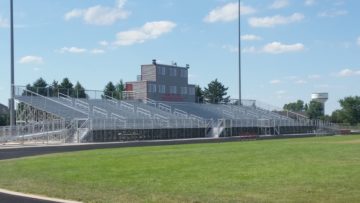By JAN LARSON McLAUGHLIN
BG Independent News
Three of the five Bowling Green city school buildings have no air conditioning – meaning the first and last weeks of the school season can be brutal for students. Superintendent Francis Scruci has referred to the sweltering students as pools of butter sitting in the heat.
“We know our buildings are hot. We know our kids melt,” Scruci said during a meeting held earlier this month.
At that same meeting, high school teacher Jeff Nichols said his classroom on the second floor of the high school reached 108 degrees one day last year. And Principal Jeff Dever asked people to come experience the temperatures. “I invite any Bowling Green resident to come to our school the second day of the school year,” Dever said.
The sauna like temperatures don’t make for a good learning – or teaching – environment.
Cooling the schools is one of Scruci’s goals as he talks about new or renovated buildings. “That certainly is one of the obstacles we have,” he said during Tuesday evening’s board of education meeting.
The superintendent has been looking for a temporary solution that might provide some relief until school buildings are renovated or replaced. But fixes are few since no ductwork exists at the high school, Conneaut or Kenwood schools.
“That presents a huge challenge,” Scruci said.
But Scruci had heard of a district with a similar situation that cooled its schools with temporary air conditioning units. The company that handled the project was asked to calculate how much it would cost to cool Bowling Green’s schools for the first weeks at the beginning and end of the school year.
The estimate for Kenwood Elementary called for 25 1.5-ton air conditioning units in the windows, costing $20,000 per month. That amount didn’t include the $3,500 for set up and tear down, or the added electric cost to run the air conditioning.
The total for cooling the high school, Conneaut and Kenwood reached $101,500 a month.
“I don’t think that’s a reasonable option,” Scruci said. “That’s not a doable number.”

New bleachers at BG football stadium
Also at Tuesday’s meeting, the board learned the new bleachers in the football stadium are nearly complete.
“We were fortunate to be on the front end of their schedule,” said Kent Buehrer, of Buehrer Group Architecture. “Some of the districts are probably worried if they can have their first home games this season.”
The new bleachers on both the home and visitor sides, along with restrooms cost the district $552,255. It became necessary for the district to replace the bleachers when the existing ones were found to be rusted underneath during last year’s football season. One section normally used for student seating was closed during the season and temporary bleachers were set up in the north end zone.
In other business, Scruci talked about issues that arose during the last meeting held about school facilities. One parent expressed concerns that the possibility of a consolidated elementary building north of the middle school on Fairview Avenue would cause very lengthy bus rides for younger students. The parent said a majority of the students live in the southern portion of the city and in rural areas to the south like Milton Center.
Scruci said at Tuesday’s meeting that 611 of the district’s elementary students live north of Wooster Street, and 592 live south of Wooster Street. A total of 193 elementary students live outside the city, with just seven residing in Milton Center.
“People will come with passionate comments, but they’re not always accurate,” Scruci said of comments made during public meetings on the building topic.
“We want to try to hear all the concerns,” he said. But some need to be pointed out as inaccurate.
Scruci has offered to meet with any community or neighborhood group about the school building issue. He will be meeting with residents in the Summerfield area, Thursday at 6:30 p.m. Anyone from the community is welcome to attend.

